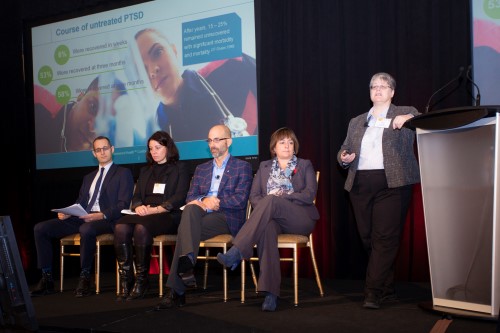
With growing awareness of the effects of post-traumatic stress disorder, what’s the role of employers in supporting employees dealing with it?
That was the focus of a panel discussion during Benefits Canada’s Mental Health Summit in Toronto last month. As Ann Malain, executive vice-president for clinical practice and stay-at-work services at with Homewood Health, explained, post-traumatic stress disorder can develop in people after exposure to a trauma — such as child abuse, domestic violence or a workplace or traffic accident — and affect those who have witnessed such incidents.
“PTSD occurs in about eight per cent of the population, so not everybody who experiences a trauma in life will develop PTSD,” said Malain. “But it can impact us. Even if it doesn’t develop into PTSD, it can contribute to depression, anxiety, substance abuse or addiction.”
Read: Ontario introduces PTSD legislation for first responders
That’s why it’s important to have a good assessment protocols in place, said Malain. “It may be PTSD or there may be other things along with it.”
As well as a treatment plan, there must also be a plan in place for an employee’s return to work. Employees and their treatment providers need to know whether there will be any triggers at work because they’ll need to build resiliency and the ability to cope with them, Malain noted. “A major contributor to the success of return to work is how connected the employee can stay with their workplace and how receptive the workplace is to bringing them back.”
Employers and managers will always be a little reluctant about returning to work from PTSD because the condition comes with some symptoms that make people uncomfortable, said Stéphane Grenier, founder and lead innovator at Mental Health Innovations. But he reminded employers to remember to not expect a cure. “Expect recovery and expect that the recovery and embracing that person coming back to work is part of that recovery.”
Read: Integrated programs key to successful workplace mental-health strategies
But to avoid an employee going on leave in the first place, employers should have mental-health programs in place to help their staff and create an environment where it’s OK to talk about the issue, panellists noted.
NAV Canada’s program, while not specifically targeted at PTSD, is for its air-traffic controllers and flight service specialists. “Even though they’re not first responders, they may be the last ones who are speaking to the pilot before an incident may happen,” said Lyne Wilson, director of talent acquisition and organizational health at NAV Canada. “And it doesn’t necessarily mean an accident. It could be a situation where the controllers were trying to find the plane for two hours. That creates stress.”
The organization also has employees who have struggled with their own mental illness volunteer to help other employees who are dealing with the issue. “We’ve been able to help remove the stigma by having employees willing to share their stories,” said Wilson.
Read: Michael Garron Hospital wins mental-health award for holistic approach
For its part, Michael Garron Hospital participates in manager training through the Morneau Shepell-Queen’s University mental-health program. The hospital also has its own in-house emotional intelligence program. “Upon hiring, whether you’re a manager, a supervisor or a front-line staff member, the expectation is very clear about how we contribute to a healthy environment,” said Christine Devine, wellness specialist with Michael Garron Hospital. “We recognize that though we’re not the people undergoing the trauma, we are witnessing people in their most difficult moments of their life. So we have to prepare for that.”
Employers need to embrace mental-health programs, but they can’t just be a checklist, said Wilson. “It has to be a holistic view. There has to be a strategy in place in terms of how to change the culture. Because a program itself or training itself won’t change the culture.”
